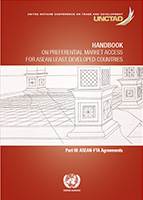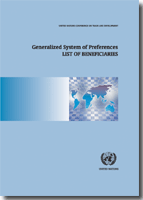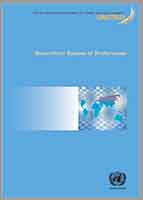The Generalized System of Preferences (GSP), established in 1971 under the guidance of UNCTAD, has played a significant role in creating a favorable trading environment for developing countries over the years.
Fourteen countries offer GSP preferences: Armenia, Australia, Belarus, Canada, the European Union, Iceland, Japan, Kazakhstan, New Zealand, Norway, the Russian Federation, Switzerland, Turkey, and the United Kingdom. However, beneficiaries often face challenges in fully utilizing the market access opportunities available under these schemes, particularly in meeting the rules of origin requirements effectively.
In 2005, during the WTO Hong Kong Ministerial, member countries agreed that developed nations and those developing countries capable of doing so would provide duty-free and quota-free market access for exports from Least Developed Countries (LDCs).
This led to improvements in various GSP schemes and the introduction of new schemes specifically for LDCs. Subsequent ministerial decisions, including the 2015 Nairobi Ministerial Declaration, reaffirmed the importance of this issue for the trade and development prospects of LDCs.
UNCTAD's support for the GSP and other preferential arrangements aims to help developing countries—especially LDCs—increase their utilization of GSP and other trade preferences, promoting the development of productive capacity and enhanced trade.
This support includes raising awareness and enhancing understanding among exporters and government officials in beneficiary countries regarding the trading opportunities available under these schemes.
It also involves strengthening knowledge of technical and administrative regulations, laws governing preferential market access, and, most importantly, the rules of origin.
Additionally, relevant information is disseminated to users of GSP and other preferential schemes, and support is provided to preference-granting countries to improve their preferential schemes.
Database on GSP utilization
Beneficiaries of the GSP schemes
The document contains a list of beneficiaries for each of the GSP schemes currently in operation according to notifications received from UNCTAD member States. Its part of a series of publications aimed at helping exporters, producers and government officials to utilize the trade opportunities available under the various GSP schemes.
While every effort has been made to ensure the accuracy of the list, the UNCTAD secretariat would appreciate being notified of any errors. We update the list periodically to reflect any modifications that may be made by preference-giving countries. The terminology used in the list for the designation of the countries and territories benefiting from the GSP schemes is that of the respective preference-giving countries.
Handbooks on the GSP schemes
These handbooks present the contents of the 10 GSP schemes in a user-friendly format, emphasizing how Governments and firms in beneficiary countries can make the best use of each scheme.
Users of a particular handbook are encouraged to do the following:
- Step 1: Check the product coverage.
- Step 2: Identify the correct GSP rate.
- Step 3: Check the preferential margin.
- Step 4: Check the origin criteria.
- Step 5: Check the consignment conditions.
- Step 6: Prepare documentary evidence.
Handbooks on Market Access and Rules of Origin for LDCs

A three-part series of handbooks on Duty-free Quota-free Market Access and Rules of Origin for Least Developed Countries.
-
Part I refers to QUAD countries (namely Canada, the European Union, Japan and the United States of America).
-
Part II covers other developing and developed countries.
-
Part III covers ASEAN free trade agreements with dialogue partners.
Events & meetings
19 – 20 November 2025
Advanced executive training on building expertise in negotiation, implementation and compliance of rules of origin and operational certification procedures (OCPs)
Siem Reap , Cambodia11 – 12 November 2025
ADB-UNCTAD rules of origin forum: Advancing convergence and simplification of rules of origin in Asia and the Pacific
Manila, Philippines30 October 2025
LDCs in a fractioned trading world: why WTO matters more than ever for LDC and how to best prepare an LDC Agenda for MC14
Florence, Italy28 – 29 October 2025
Executive meeting on negotiating and drafting rules of origin (RoO) for the LDC WTO Group in preparation for MC-14
Florence, ItalyGSP Certificate of Origin, Form A
The claim for GSP treatment must be supported with the appropriate documentary evidence. The GSP Certificate of Origin Form A is used for this purpose.
The Form A was adopted in 1970 by the UNCTAD´s Working Group on Rules of Origin as a common certificate of origin for the purposes of the GSP (TD/B/AC.5/38).
Most recently, changes to the Form A were made:
- In September 2013 to take into account the accession of Croatia to the European Union as well as the introduction by Iceland of unilateral duty-free and quota-free market access for imports of certain products originating in least developed countries (Notes 2013)(TD/B/GSP/FORM/4)
- In July 2007 to take into account the European Union´s enlargement and to include the Principality of Liechtenstein, leading to a revision of the note on the Back of the form (Notes 2007) (TD/B/GSP/FORM/3)
- In July 2005 to take into account the new GSP scheme of Turkey, leading to a revision of the note on the back of the form (Notes 2005) (TD/B/GSP/FORM/2/Rev.1)
- In April 2004 to take into account the European Union´s enlargement, leading to a revision of the note on the back of the form (Notes 2004) (TD/B/GSP/FORM/1)
The Trade and Development Board, at its forty-first session of the Trade and Development Board, held from 18 to 20 April 2007, agreed that the old Form A with notes dated 1996, 2004 and 2005 will remain valid until existing stocks are exhausted.
Certifying Authorities
The beneficiary countries should inform the preference-giving countries, either directly or through the UNCTAD secretariat, the names and addresses of the governmental authorities issuing the GSP Certificate of Origin Form A together with specimens of stamps used by these authorities.
However, it is not required to notify the specimen of signatures or the names of persons authorized to issue Form A.
Download:
FORM A - certificate of origin (Combined declaration and certificate)
English | French









